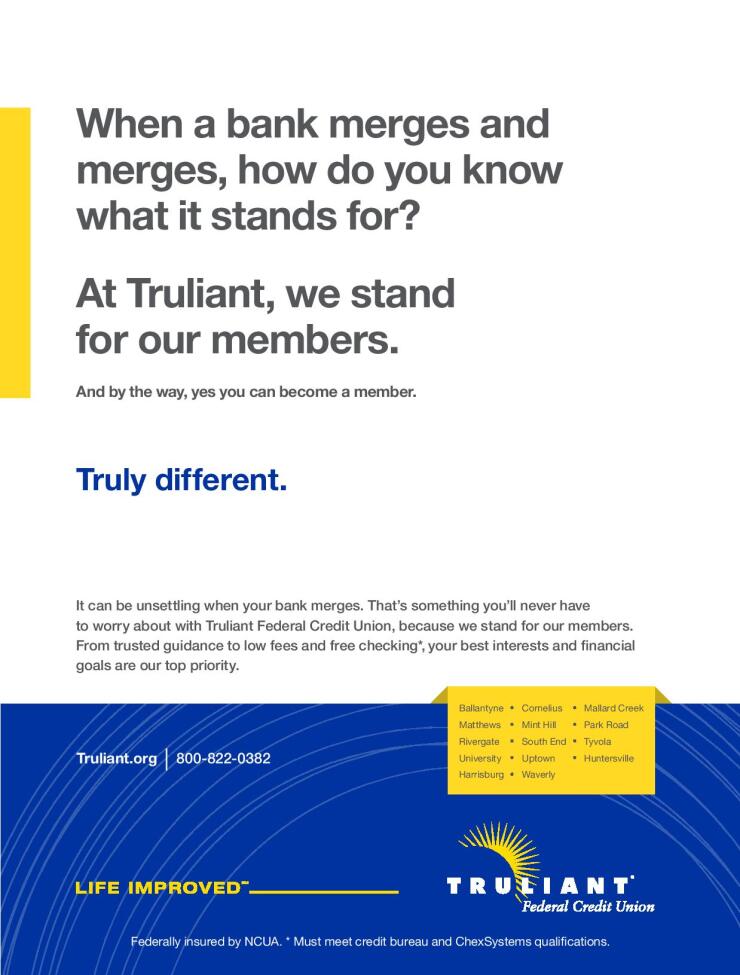Truliant Federal Credit Union, a $2.2 billion institution based in Winston-Salem, N.C., has undertaken a rather audacious marketing campaign to help distinguish it from the competition – by unequivocally promising never to merge.
The ad strategy is particularly relevant to residents of parts of the bank-heavy Tar Heel State, like the Piedmont Triad and Charlotte, who have witnessed wave after wave of banking mergers and consolidations. These customers, the credit union noted, are often left “feeling disenfranchised,” since a primary driver of using a community bank is a desire to be a part of a local institution rather than a larger regional or national bank.
The new campaign highlights other differences between Truliant and banks, including free interest checking, a variety of low-rate options on auto loans, home equity loans and lines of credit, mortgages and other loans.
The campaign was launched over the Memorial Day weekend and will eventually involve various forms of media, including print advertising, billboards, direct mail, social media and a special merger page on Truliant’s website.

In an interview with Credit Union Journal, Chief Marketing Officer Karen DeSalvo explained that the merger issue has continued to be top of mind in North Carolina as local residents have watched community banks disappear on what seems to be an almost daily basis.
“There are currently ten active mergers in the communities we serve,” she said. “The merger of two (or more) financial institutions can be unsettling for consumers, who face the uncertainty of new management, the potential for higher fees and the possibility of branches closing.”
She said she hopes that this through this awareness campaign, consumers affected by these mergers “will consider us as a better banking alternative.”
This ad campaign will run for several months throughout the year, DeSalvo added, during this period of bank mergers “where consumers feel the most pain points of the [ongoing] mergers.”

Truliant plans to measure the campaign’s success by monitoring membership and loans, and DeSalvo said the credit union will “certainly track activity in communities where the campaign is running.”
A crucial element of a campaign like this, she said, lies in “seizing the opportunity to communicate our differences from banks to those who may not be aware of how credit unions are different. For us as a credit union, it’s a way to communicate that we’re driven by doing what’s best for our members, not for increasing profits.”
Thus far, on an anecdotal basis, the reaction to Truliant’s campaign from members has been “very positive,” DeSalvo said.
“We had a visitor to our Matthews, N.C. location, whose bank had merged twice in the last few years,” she recalled. “He said he never switches financial institutions since he believes in the full relationship, however, he couldn’t take it anymore. He saw our ad about bank mergers and that we would never merge, and said ‘I knew I had to know more about Truliant.’ There’s a lot of value in letting people know we won’t put them through this.”
Subsequently, she said, the man became a member, opened several accounts and brought a full range of banking products from Truliant. “We were able to do a lot for him, saving him almost two hundred dollars per month,” DeSalvo added.
Never say never
But can a credit union (or any organization) truly follow up on a vow never to merge, especially given that M&A activity is a reality in the economic landscape?
Truliant has been a part of the merger process in the past, but on the acquiring end. In late 2012, the credit union acquired the tiny $2.4 million New River Valley Truck Plant Federal Credit Union of Dublin, Va. In 2004, Truliant merged with Victory Masonic Credit Union, a small black-owned institution based in Winston-Salem, N.C.
DeSalvo explained that thanks to Truliant’s more than $2 billion in assets, it has the economies of scale to provide members with modern banking technologies along with an extensive branch network, meaning it is extremely unlikely ever to merge into a larger institution.
“Most mergers occur [as a result of] being unable to effectively serve your membership,” she said. “We have no to plans to merge -- ever.”
In addition, DeSalvo asserted that Truliant will not itself be buying up smaller credit unions.
“We do not buy credit unions,” she said. “Over the years, a few smaller credit unions have asked to merge with us out of hardship or to be able to provide their membership with additional services that they were unable to deliver, due to their size.”
Rather than merge, Truliant has been expanding in the key Charlotte market. It now has a total of 14 branches in the Charlotte metropolitan area.
A word of praise
Jim Blaine, the former CEO of $36.5 billion State Employees Credit Union of Raleigh, N.C., and a well-known credit union figure in the state, praised the ad campaign, describing Truliant as “a great credit union” and one that is “well managed.”

“I believe they are responding to concerns by North Carolinians about the disappearance – via mergers with out-of-state banks – of so many of our local community banks,” Blaine told Credit Union Journal. “Most folks prefer high-quality, local institutions if available.”
Blaine further asserted that he thinks Truliant will honor its commitment to remain independent, “unless the member-owners choose otherwise – [and] that's the member’s choice.”
A differing view
Paul Lucas, a credit union marketing and branding expert, was less confident that Truliant will be able to back up its promises to never merge.
“If the ad had offered Truliant FCU’s intent to not merge as one proof statement of their commitment to their members it would have made sense,” Lucas said. “However, as a stand-alone premise, it is abstract and somewhat confusing.”
If credit unions wanted to invite banking “refugees,” as Lucas called them, to join the CU, that would make a lot more sense, he said.
“The benefit here is security and commitment to the consumer,” he added. “That makes a case for what Truliant FCU will do for them, not what it will not do to them. That creates more of an emotional connection.”
Moreover, a board of directors and CEO should never make a promise that the organization might not choose to keep in the future, Lucas added.
“Ultimately, this ad should reassure Truliant FCU’s current members they made a good choice in selecting the credit union, offer stability to merger-weary bank customers and make Truliant FCU employees [know] they are part of the team,” he concluded.
The bigger picture
Truliant may have one trend on its side: merger activity among credit unions has fallen in recent years. According to Callahan & Associates, the number of mergers involving credit unions has dropped from 274 in 2014, to 229 the following year, then 224 in 2016. Through the first quarter of 2017, there have been only 39 mergers – suggesting, at this pace, another drop for this calendar year as a whole.

But does this really mean that credit unions are now less interested in merging?
Callahan’s director of industry analysis Sam Taft said it depends how one looks at it. “The number [of mergers] has declined slightly, but so have the number of credit unions,” he told Credit Union Journal. “If you look at the number of mergers as a percentage of the total number of credit unions, it’s actually held pretty steady over the last several years – about 3.5 percent.”
Moreover, Taft noted, the majority of mergers are occurring with relatively small credit unions – those with assets below $20 million. Smaller institutions simply cannot survive, much less compete, due to rising competitive pressures and their economies of scale.

And the number of credit unions is likely to keep shrinking.
Dennis Dollar, a former NCUA chairman and now principal partner of Dollar Associates, a credit union consulting firm in Alabama, believes consolidation will persist in the industry for “the foreseeable future” due to market considerations and regulatory and compliance issues.
However, Dollar cautioned that the rate of such mergers may slow down a bit partly due to field of membership restrictions and stricter disclosure requirements.
“Federal credit unions with [dissimilar] FOM cannot get NCUA approval to merge their memberships in most cases,” he said. “Both the FOM restrictions and the enhanced disclosure requirements are making some mergers take longer and are making some credit unions question whether the voluntary merger is worth the fight.”





